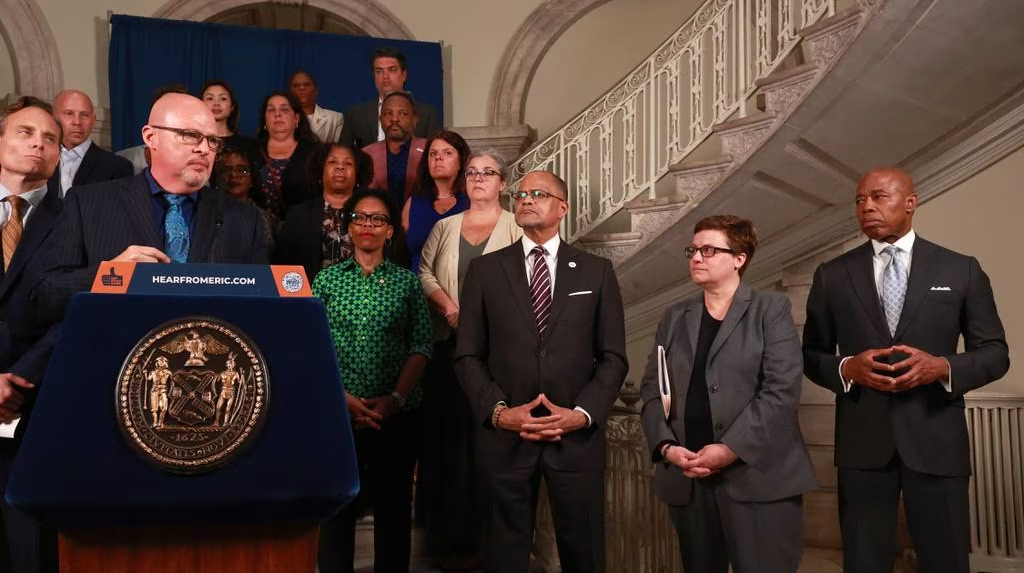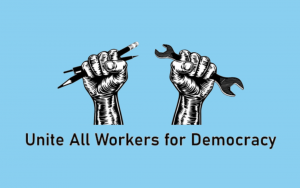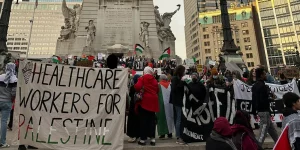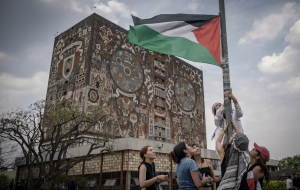On Monday, the United Federation of Teachers (UFT) ratified a five-year contract covering nearly 200,000 public school workers across New York City. The contract, which will last until November 2027, went into effect immediately and is retroactive to September 2022 when the previous contract expired.
Just a few weeks ago, the majority of my coworkers and I voted no on this contract.
About 75 percent of the roughly 95,000 members who cast ballots voted to ratify, according to a tally by the American Arbitration Association. Though the union leadership is calling this an “overwhelming majority,” 25 percent voted against the contract or didn’t vote at all — amounting to about 24,000 people who were either alienated enough to abstain or informed and heated enough to vote no.
The occupational and physical therapists, school nurses, audiologists, and supervisors of nurses and therapists, however, voted down their tentative agreement, as they did in 2018, with 60 percent rejecting the proposal.
Between the continued racist and gendered pay inequities between titles, “raises” that amount to inflation-adjusted cuts, hidden healthcare giveaways, insidious expansion of virtual learning, and an undemocratic negotiation and ratification process, this contract is hardly the win that city and union leaders are making it out to be. For the hundreds of thousands of rank-and-file educators of New York City, a long fight is ahead.
Working Under Austerity
UFT president Michael Mulgrew claimed that the contract “addresses the major changes sought by the union’s 500-member negotiating team.” In reality, it doesn’t come close to meeting the five primary contract demands of the United for Change coalition, nor many of my coworkers’ most basic concerns about our compensation and working conditions.
Instead of offering real raises, the contract includes unpensionable bonuses to tempt us into voting yes. This includes a one-time $3,000 ratification bonus, with yearly retention bonuses, as Mayor Eric Adams said, to “ensure we are holding on to our valuable educators.” As we will see, there is very little that would actually ameliorate the underlying factors that result in these retention issues in the first place.
In a press release, Adams said he was “proud” that the “valuable educators” of New York City ratified the contract, touting the “much-needed wage increases” for public school employees.
This endorsement is a red flag coming from charter–friendly Austerity Adams, who cut hundreds of millions of dollars from the schools last summer, forced through the privatized Medicare Advantage Plan for retirees, halted the expansion of the city’s free pre-kindergarten program, and proposed additional massive cuts to the public school budget (in addition to libraries, CUNY, and other social programs), saying he needs to “make smart financial decisions”. While for the time being, the 2024 New York City budget passed earlier this month has avoided many of the draconian billion-dollar cuts he originally proposed, we should be clear that a contract that meets Adams’s standards is no win for the city’s workers.
For his part, Mulgrew has defended the contract tooth and nail since the memorandum of agreement was released in mid-June while minimizing the very real concerns of the rank and file. In a press release, Mulgrew praises the contract, saying it “increases pay, increases educators’ control over their workday, and decreases the non-educational, irrelevant paperwork demands.” But that statement doesn’t hold up to scrutiny.
These “raises” Mulgrew speaks of — starting at 3 percent in the first three years and increasing to 3.25 and 3.5 percent in the last two, respectively — represent a pay cut over the course of the contract. The 3 percent raise for the 2022 period occurred when inflation hovered around 8 percent — amounting to a 5 percent loss in wages when accounting for the cost of living. When we consider the unpredictable inflationary trends of the past several years — driven by supply chain issues, geopolitical conflict, and other factors, increasingly common in the crisis-ridden capitalist system —there’s reason to believe that public education workers will continue to struggle to make ends meet in the years to come.
Even taking for granted these deceptive wage increases, the contract still sells out union members serving the most underserved students: the paraprofessionals. Under this contract, their starting wage is only around $30,000. Even after 15 years of experience, paraprofessionals workers can’t even reach an annual income of $60,000. In one of the most expensive cities in the world, that amounts to poverty wages.
It’s important to put these numbers in context. According to the 2023 True Cost of Living Poverty Report, 50 percent of working-age New Yorkers are struggling to cover their basic needs. Across the five boroughs of New York City, the average income needed to cover only the basic needs for two adults and two young children is approximately $125,000. There is no reason anyone with a full-time union job should have to take on a second job to make ends meet. This salary is unlivable in New York City for paraprofessionals and other titles, positions that are more likely to be held by people of color. This is nothing less than racist hyper-exploitation of a population that has been historically underserved by the same institutions that they are now working for.
On top of all of this, the contract ratification coincided with the opaque process of healthcare givebacks by the Municipal Labor Committee (MLC). The MLC is the umbrella organization of all New York City public-sector unions that negotiates directly with the city on healthcare. District Council 37 (DC37) and the UFT are the two largest unions, and therefore have the most influence in the MLC. During the last round of contract negotiations in 2018, the MLC (again, controlled by DC37 and the UFT) inconspicuously agreed to hundreds of millions of dollars of yearly healthcare “savings” (read: cuts). The new plan is yet to be announced, but public sector workers have every reason to suspect the coverage will be worse based on the attempts to move the city’s 250,000 municipal retirees onto a privatized Medicare Advantage plan, a switch which has been temporarily blocked in court due to tireless activism by the retirees and their allies.
Worsening Working and Learning Conditions
On top of the economic weaknesses of the contract, it leaves much to be desired in terms of real improvements to our working conditions and our students’ learning conditions.
First, the contract does nothing to address the systemic inequities for the most underserved students in a city with some of the most segregated schools in the country. It doesn’t address some of teachers’ major and most basic concerns, such as our overcrowded classrooms. There is no language to reduce class sizes and caseloads, which experts believe will remain unaffected by the new state law due to lack of compliance by the Department of Education.
There are notably few gains for special education or ELL (English language learner) teachers — even as schools struggle to provide for students who are migrants and refugees, who have learning differences, or who need mental health support. In a city that has more cops in schools than counselors, this contract doesn’t meaningfully improve students’ learning conditions, which are one in the same as their teachers’ working conditions.
One of the most concerning aspects of the contract is its virtual learning pilot program, which has created a lot of question marks for both teachers and students. While virtual learning was a major component of the rank and file’s demands for safe school reopenings during the height of the Covid pandemic, the creation of a permanent virtual learning program for all schools in the city is problematic.
This program, which will start with selected pilot schools and will reach 100 percent of schools by the end of the contract, will include more “flexible” learning options for students, with weekend and evening classes. With no protections against subcontracting out to private companies or protecting union jobs, what this program really does is open the door for privatization while deteriorating the quality of education.
Mayor Adams claimed that this program will help “set our young scholars — including those with nontraditional schedules — up for success.” There has been lots of veiled language around these students with “nontraditional schedules” or “different circumstances.” Who are these students, exactly, and what circumstances are we talking about?
While there are students who do genuinely benefit from virtual learning, such as some students with disabilities or students with chronic immunosuppression, that does not apply to the majority of students in New York City public schools.
These circumstances that city leaders are talking about is poverty. With more and more families struggling to make ends meet, many children work jobs outside of school; in 2022 alone, there was a 68 percent rise in child labor violations in New York., which has increased in the wake of the Covid pandemic. “Flexibility” is really a euphemism for pushing low-income students out of the traditional classroom setting. As Jai Gellar and Jia Lee wrote recently, we need a teachers union that “demands universal access to good jobs, healthcare, and housing … not indulge an exploitative system where so many students must work to help support their families.”
That’s the problem: This contract doesn’t meaningfully address the underlying needs of New York City’s public school students and their families, nor the exhausting and demoralizing working conditions of its workers. Heavily-taxed yearly bonuses will never make up for the leadership’s failure to bargain in the interest of the working class and our children.
A Culture of Opacity
Beyond the specifics of the deal, what is most horrendous about the 2023 contract is the undemocratic and opaque process to reach it. After the contract expired in September, the membership was given very few updates on negotiations beyond when the committee was meeting, and a few meetings and actions to mobilize for a “fair contract” — the details of which were completely concealed.
While the 500-member negotiating team was historically large and more representative of the rank and file compared to previous years (which was pushed for by rank-and-file caucuses in the UFT), all members of this committee were forced to sign non-disclosure agreements (NDAs) in order to take part in negotiations. As the negotiating team was hammering away behind closed doors, the rank and file were left completely in the dark on what the concrete demands actually were until they saw the memorandum of agreement. When the TA was released for viewing, it was rushed to a vote with scare tactics and misinformation to pressure members to ratify, warning that if we didn’t vote yes now, we’d get kicked to the back of the bargaining line behind all the other city unions and, in the meantime, return to a widely hated pre-2014 school day schedule.
When the tentative agreement was reached on June 13, the delegate assembly had to fight to make the entire memorandum of agreement available for the membership to read. Meanwhile, we were racing through the final week of the school year, busy preparing for Regents exam administration and finishing our end-of-year tasks. Yet we were expected to vote by the next Friday — hardly enough time to read, digest, and discuss a document that would establish the working conditions for the next four years.
In a democratic union, rank-and-file voices would be actively sought through a variety of different methods to ensure accessibility for all members, demands would be formulated through a collective and transparent process, the MOA and TA would be openly debated and discussed, and negotiations would be open for every member of the union to attend. But that’s not how the UFT, in its current bureaucratic and top-down form, operates.
The concessions in the contract that New York City teachers did get — shorter professional development, improved family leave, and increased bereavement time among them — would not have been won without the efforts of rank-and-file members who pushed for greater democracy in the process. Only after massive efforts to pressure the leadership by these rank-and-file caucuses, such as MORE-UFT, were there Contract Action Teams (CATs) and rank-and-file members on the negotiating committee.
A vote no campaign is a massive undertaking, and it’s not shocking, given the organizing conditions, that this contract passed. In fact, it’s a progressive sign that only 75 percent voted in favor, compared to the 2018 contract that passed with 87 percent approval. This could point to a growing skepticism in the top-down business unionism practiced by Mulgrew and his Unity Caucus, and the undemocratic methods that underscore the fight for better working conditions.
We Must Prepare to Fight Anti-Strike Laws
The elephant in the room underscoring the entire ratification process: the strike.
Workers’ most powerful weapon against the bosses is our power to withhold our labor and hit them where it hurts: their profits. But in New York State, public sector workers are told that this weapon isn’t available to us because of the Taylor Law. Passed in response to the 12-day 1966 transit strike to replace the even more severe Condon-Wadlin Act, the Taylor Law maintained the illegality of public sector strikes, penalizing collective action and targeting the union with harsh penalties to end strikes. Today, the Taylor Law continues to deter strikes and stunt militancy among public sector workers.
Fighting anti-worker laws cannot be challenged merely through legislative efforts aimed at reforming or repealing them — though we should support all efforts to do so in order to make it easier for workers to organize. We need to fight for a union that will take a clear stance against the Taylor Law and undertake a serious campaign of strike preparation. Even Mulgrew brought up the potential for a strike during an interview in late May. The union needs to be willing to seriously stand up to these anti-worker laws and be prepared to break them, with a robust campaign to organize the membership, educate members about what it means to strike, and build strike committees in every school.
Collectively withholding our labor is an essential tool of the working class to win concessions from our bosses and win broader demands. The most essential labor rights were won through strikes far before it was legally protected to do so. Before the mid-1930s, strikes weren’t legally protected at all; in fact, they became legal through a rolling and roiling strike wave that started in 1930 and ran throughout the decade. It was the strike itself that won the legal right to strike, and it is the strike that will win educators the working conditions we deserve.
Many point to the 2005 New York City transit strike — the failure of which paved the way for austerity in the city in the next 20 years — to warn against the potential consequences of defying this law. But there’s a reason why this strike was so heavily repressed: the city stood to lose nearly half a billion dollars for each day the workers withheld their labor. The problem there wasn’t the fact the workers went on strike — it was the lack of wider solidarity among other workers ready to use their power, too.
If the UFT is going to break the Taylor Law, we can’t do it alone. We need the public sector rank and file of DC 37, TWU, PSC-CUNY, NYSNA, and all other public- and private-sector unions in New York City to be ready to join in solidarity — as well as our students, their families, our communities, and all working people. The 2005 strike reminds us that our greatest power lies in our role as workers — in our ability to shut it down to get what we and our students deserve.
This new contract is bad, but we are now armed with the knowledge that at least 20,000 rank-and-file educators are either feeling alienated by the leadership’s top-down business unionism, or are just as angry as we are. That’s an excellent place to revitalize our fight, with even clearer eyes and more fire. To the rank-and-file members who have been long fighting to build a more democratic union and to those who are just entering the battle: let’s continue to build power with our coworkers in our schools, organize within and across our unions, and find out what we can win when we fight together.











